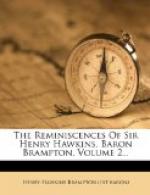[Footnote A: In this and one or two other cases I am pleased to acknowledge my thanks to my esteemed friend Mr. Charles W. Mathews, the distinguished advocate, for refreshing my memory with the incidents.]
One of the most diabolical cases which came before me while a Judge was one which, although it occupied several days, can be told in the course of a few minutes. I mention it, moreover, not so much on account of its inhuman features as the fact that, in my opinion, Dr. Lamson led the prosecutors—that is, the Government solicitors—into a theory which was calculated by that cunning murderer to save him from a conviction, and it nearly did so.
The story is this:—There was in the year 1873 a family of five children, one of whom died that year and another in 1879, leaving two daughters and a poor cripple boy of eighteen. He was partially paralyzed, and had a malformation of the spine, so that he was an object of great commiseration. He was of a kind and cheerful disposition, and, excepting his spinal affliction, in good health. He seems to have been loved by everybody. His playmates wheeled him about in his chair so that he might enjoy their pastimes, and even carried him up and down stairs. One of this boy’s sisters married a Mr. Chapman; the other married a man who was a doctor, or passed as one, of the name of Lamson. He was a man of idle habits, luxurious tastes, and a wicked heart. He was in debt, had fraudulently drawn cheques when he had nothing at the bank to meet them, and was so reduced to poverty that he had pawned his watch and his case of surgical instruments.
By the death of the brother in 1879, the two sisters received each a sum of L800. This boy, Percy, received the like amount, and if he should live to come of age would have a further sum of L3,000; but if he died before that period, one-half would go to Mrs. Chapman and the other half to Mrs. Lamson, the doctor’s wife.
Lamson had bought a medical practice at Bournemouth in 1880, but very soon after writs and executions were issued against him.
For three years before Percy’s death he had been at school at Blenheim House, Wimbledon.
It appeared from his statement while dying that he felt just “the same as I did once before, when I was at Shanklin with my brother-in-law,” the doctor, “after he had given me a quinine pill.” “My throat is burning, and my skin feels all drawn up.” This pill, however, did not kill him, but it showed, as subsequent events proved, the murderous design of Dr. Lamson.
On December 3 the boy, being still at school and in good health, was amusing himself with his schoolfellows when his brother-in-law, the prisoner, called. Percy was taken into the room to see him. “Well, Percy, old boy,” said the doctor, “how fat you are looking!” The doctor sat down, and Percy was seated near him. The visitor then took out of a little bag a Dundee cake and some sweets, and cut a small slice of the cake with his penknife. About fifteen minutes afterwards he said to Mr. Bedbury, the master, “I did not forget you and your boys: these capsules will be nice for them to take nauseous medicines in;” and he took several boxes of capsules from the bag and placed them on the table. One box he pushed towards Mr. Bedbury, asking him to try them.




